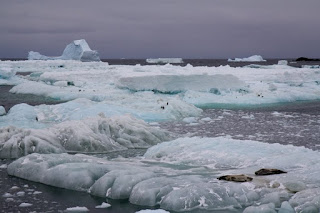Ice plays a significant part of our lives here. If there is too much ice in the bay the ship can't get in and we have to find another way to drop off people and supplies. Here is the bay, still full of sea ice when we arrived this year. Too thin to walk on, yet too thick to drive boats through.

The salty sea ice tends to break up fairly quickly in the spring, which allows the larger freshwater icebergs, carved from glaciers on the Antartic continent to drift northwards to us instead. This creates new challenges because bergs can ground in the bay, squashing our water inlet pipes, meaning we cannot generate fresh water.

On a sunny day, the ice turns various shades of blue.

Generally, the clearer the ice, the older it is. Some of it will have fallen as snow on the Antarctic continent thousands of years ago, slowly getting compressed over the years until all the bubbles have been squashed out of it, forming completely clear glassy lumps.

The action of the waves then forms beautiful scalloped surfaces on the ice, which can create lovely patterns.


Even small chunks of ice can look pretty. This one is only a couple of inches high. The water in these is very pure, and if placed in a gin and tonic (or other drink!) will pop and fizz as the compressed bubbles escape.

The wildlife enjoys the ice too. Weddell seals can frequently be seen sleeping on the ice, and penguins use them as a place to haul out of the water or as a means of travel.

A good iceberg sunset is hard to beat.




No comments:
Post a Comment